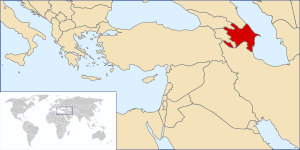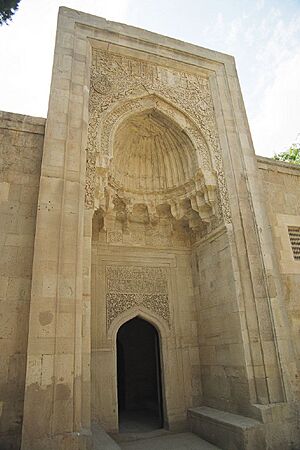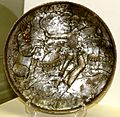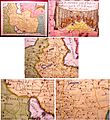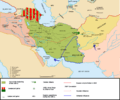History of Azerbaijan facts for kids
The history of Azerbaijan is super old, going all the way back to the Stone Age! This country has a long and interesting past, with many different groups of people living there over thousands of years.
Contents
Azerbaijan's Early History
The name Azerbaijan has been around for many centuries. Its spelling changed often over time. Old records show names like Andirpatian, Atropatena, Adirbijan, and Azirbijan.
Scientists have found very old tools and bones in Azerbaijan. These show that people lived here about 1.7 to 1.8 million years ago, during the Stone Age. Later, important early civilizations grew in Azerbaijan. These included Mana, Scythia, Atropatena, and Caucasian Albania. They appeared around 1000 BC. Caucasian Albania was somewhat independent. However, it was also influenced by the Roman and Persian empires.
Middle Ages and the Arrival of Islam
In the 7th century, a big change happened. Arab people conquered the area and brought the religion of Islam. This was a very important event for Azerbaijan. It helped create a single nation and language. Most people became Muslim.
Having one main religion helped different groups of people come together. They started sharing traditions and becoming one community. By the mid-9th century, the Turkic people, known today as Azerbaijanis, became the largest ethnic group.
Forming a United State
Between the 15th and 18th centuries, Azerbaijan became a united state. This was a key time in its history. A ruler named Shah Ismail Khatai (1501-1524) was from Azerbaijan. He brought all the Azerbaijani lands under his control. He started the Safavid dynasty. Its capital city was Tabriz. During the Safavid rule, the Azerbaijani language became the only official language.
After the Safavid dynasty, another Azerbaijani commander, Nadir Shah Afshar (1736-1747), took over. He started the Afsharid dynasty. He made the country's borders stronger. In 1739, he even invaded North India, including Delhi. After Nadir Shah died, his dynasty became weak. This led to many smaller states forming in Azerbaijan in the late 18th century.
Division of Azerbaijan
In the late 18th century, the Qajar dynasty took power in Iran. They were also from Azerbaijan. Their main goal was to unite all the lands their ancestors once ruled. This led to long wars between the Qajars and Russia. Both wanted to control the South Caucasus region, where Azerbaijan is located.
Because of these wars, Azerbaijan was divided. The northern part became part of Russia. The southern part stayed with Iran. This is why today there is the independent Republic of Azerbaijan (North Azerbaijan) and a part of Iran called "South Azerbaijan."
Russian and Soviet Rule
Azerbaijan came under Russian rule after wars between Persia and Russia from 1804 to 1813. The country gained independence for a short time after World War I.
When the Russian Empire collapsed in 1917, Azerbaijan joined Armenia and Georgia. They formed a short-lived country called the Transcaucasian Democratic Federative Republic. When this republic ended in May 1918, Azerbaijan declared its own independence. It became the Democratic Republic of Azerbaijan on May 28, 1920. This was the first modern, non-religious parliamentary republic in the Muslim world.
However, this independence did not last long. The Red Army, from the newly formed Soviet Union, took over Azerbaijan. On April 28, 1920, Azerbaijan became the Azerbaijan Soviet Socialist Republic.
Azerbaijan in the Soviet Union
During and after World War II, Azerbaijan was very important for the Soviet Union. It produced a lot of oil. This oil was crucial for the Soviet Union's energy needs.
Later, the Soviet leader Mikhail Gorbachev started reforms called "glasnost." These changes led to riots and fighting between ethnic groups in many parts of the Soviet Union. This included Nagorno-Karabakh, a region in Azerbaijan. People in Azerbaijan were upset because the Soviet government did not help solve the conflict between Azerbaijanis and Armenians. This led to calls for independence.
In January 1990, a terrible event called "Black January" happened in Baku, the capital. Many people were killed. Azerbaijan finally declared its full independence on October 18, 1991. The Soviet Union officially ended on December 25, 1991.
Modern Independence
When Azerbaijan became independent, the conflict with Armenia over Nagorno-Karabakh turned into a full war. This war lasted from 1991 to 1994.
In 1993, a politician named Heydar Aliyev became the President of Azerbaijan. He helped bring stability to the country. A ceasefire, which means a stop to fighting, was signed between Azerbaijan and Armenia in 1994. This ended the war. However, about 20% of Azerbaijan's land is still occupied by the Armenian military. The two countries are still officially in a state of war.
Since then, representatives from Armenia and Azerbaijan have been holding peace talks. These talks are organized by the "Minsk Group" of the Organization for Security and Co-operation in Europe (OSCE). Their goal is to solve the conflict and return the occupied territory to Azerbaijan.
When Heydar Aliyev passed away in 2003, his son Ilham Aliyev became the President. He continues his father's policies today. Azerbaijan is a major producer of oil and natural gas. Because of this, its economy is growing very fast every year. The country has become very rich as a result.
Images for kids
See also
 In Spanish: Historia de Azerbaiyán para niños
In Spanish: Historia de Azerbaiyán para niños


